Menma from Bamboo Forests: The Tenryu River Gorge Project
Jun 03,2021
Menma from Bamboo Forests: The Tenryu River Gorge Project
Jun 03,2021
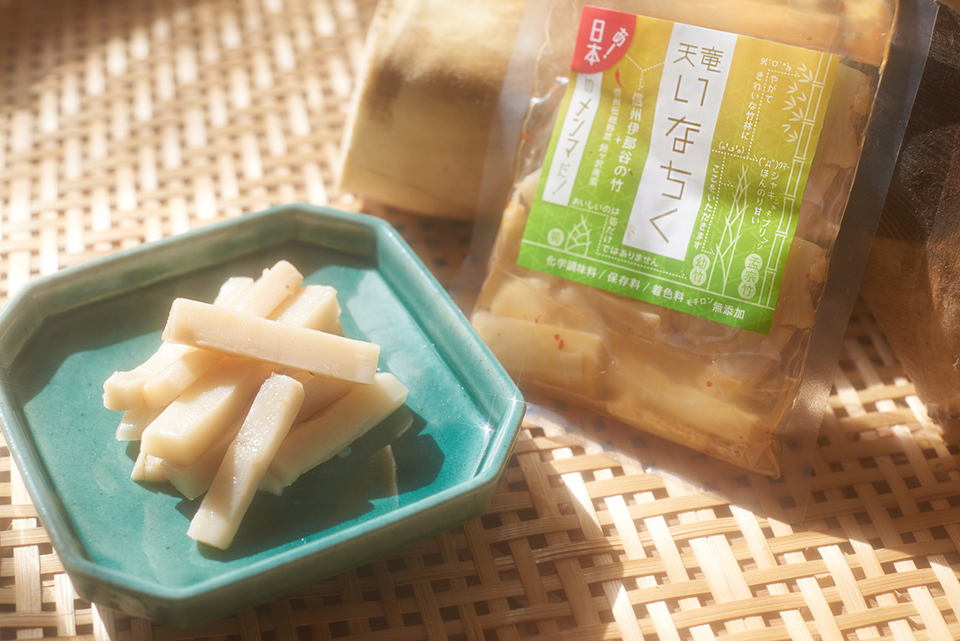

Boating down the Tenryu, soaked by the spray.
So goes a verse from the Ballad of Ina, a traditional folk song of the Ina Valley region of Nagano Prefecture. A boat trip down the Tenryu River is indeed an unforgettable experience. There’s nothing like the exhilaration of journeying downstream as the boatman skillfully maneuvers the oar. And the view of Garyu Gorge from below on the river is truly stunning.
But in recent decades the gorge lost its pristine beauty as it became overgrown with bamboo and littered with illegally dumped industrial waste and household garbage. Some concerned local boatmen therefore decided to take matters into their own hands. They doggedly chopped down the bamboo and built rafts with it for the enjoyment of tourists. They also used the shoots of the plant to produce a fermented food called menma or pickled bamboo sprouts. They thus succeeded in restoring the Tenryu River’s magnificent Garyu Gorge to its former glory while giving a boost to the local economy. To learn the story of how they did it, we talked to Sonehara Muneo, leader of the Tenryu River Garyu Gorge Revival Project, and product coordinator Ito Takako.
The appearance of Garyu Gorge gradually started to change after flooding swept away the onsen inn overlooking the river in 1961 and the flow of visitors dwindled to a trickle. The bamboo forest behind the inn steadily expanded, eventually swallowing up the natural colors of the seasons.
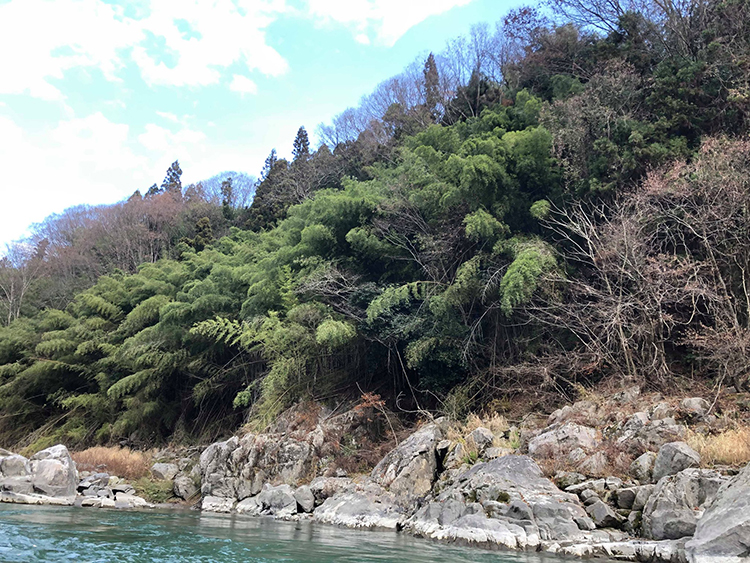
Garyu Gorge before restoration. Overgrown with bamboo, it looked dark and brooding.
“The gorge should have been a delightful vista of cherry blossoms in spring and blazing red leaves in fall. Instead, it was now covered in thick green bamboo throughout the year.” So says Sonehara Muneo, leader of the Tenryu River Garyu Gorge Revival Project and head of planning with the regional tourism division of Shinnan Koutsu. He is also a boatman himself.
To make matters worse, the slopes of the gorge, being so dark and secluded, became a prime dumping ground for industrial waste and household garbage. A decade ago, Garyu Gorge was such a sorry sight that you would have hesitated to show it to sightseers.
In 2012, therefore, Mr. Sonehara and several other concerned boatmen decided to take matters into their own hands. They made their way into the thick bamboo forest equipped with saws and started chopping down the plants by hand. Meanwhile, Mr. Sonehara approached the city’s environment department about getting the garbage removed. His petition was passed on to the prefectural government and then to Tokyo, only to be sent back to the city government. Mr. Sonehara kept making his case, though, and when the authorities saw how he refused to be discouraged, they finally agreed to clear the entire gorge of garbage. There were several dozen truckloads of it.

Local residents with the boatmen who volunteered to clear the bamboo.
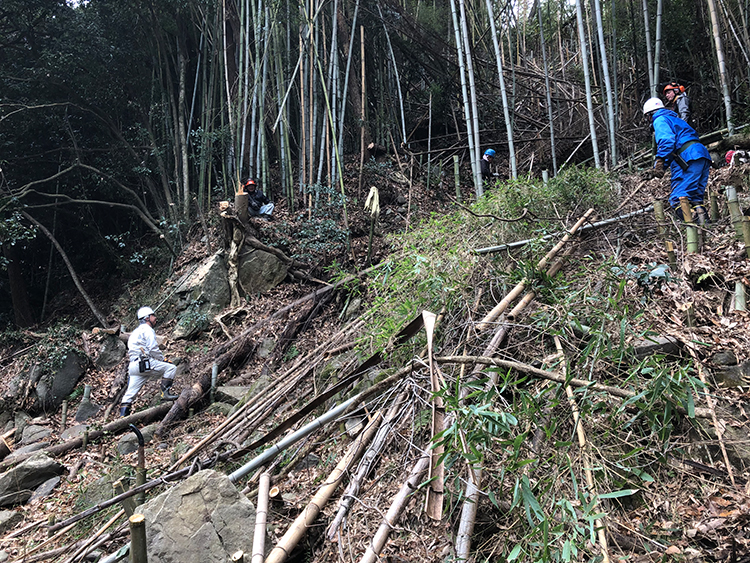
The felled bamboo was removed by boat.
“At the same time, we proceeded to chop down the bamboo in cooperation with the landowners. Sometimes it could be heartbreaking. Like, we thought the land had been completely cleared, but then the winter snow was so heavy that the bamboo snapped, and the bamboo forest was back before you knew it. Then one day I was rowing along when I noticed a sparkle on the water. I looked up, and there was a fellow from the neighborhood cutting down bamboo. He had created a gap in the forest, and the sun was shining through. As I stood in the boat watching him approach the riverside, he offered me words of encouragement. ‘We mustn’t give up. Let’s hang in there.’”
The felled bamboo was, for the time being, transported to the parking lot for river boat passengers. In no time, though, it had formed such a huge pile that the question arose of what to do with it all.
The first thing that occurred to Mr. Sonehara and his companions was to build a fleet of rafts. They rigged up a raft of bamboo, and when they took it on the river, it was even more fun than they had anticipated. That convinced them that the idea was worth pursuing. An event was therefore organized for the public called the Tenryu Raft Festival, which was every bit as successful as expected. Bamboo rafting became known as a new form of recreation virtually overnight.
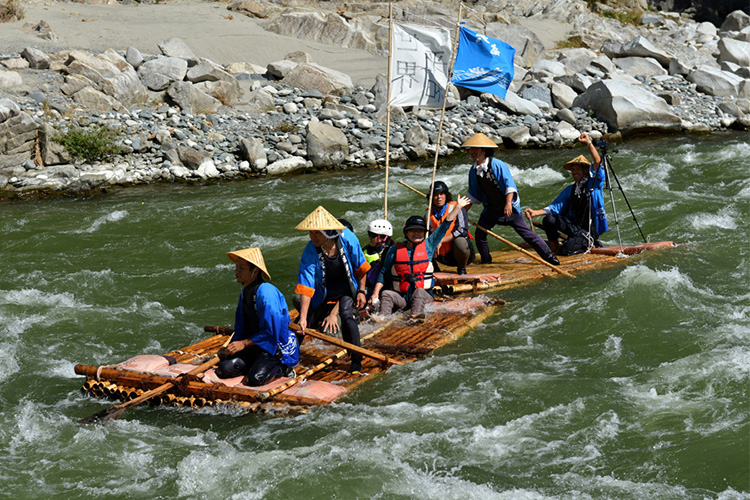
Rafts that had developed splits and were no longer river-worthy were recycled as fuel in a bamboo boiler. Water was boiled in a traditional Japanese-style boat that had seen better days. This was then used for warming chilled limbs after rafting on the river or as a footbath. The cycle was now complete.
It seemed that the problem was solved. But then a new headache cropped up: piles and piles of bamboo shoots—“the curse of my existence,” as Mr. Sonehara describes them.
“Any bamboo shoots you fail to remove in the spring shoot up in an instant, growing into young bamboo plants taller than a person. Left untended, they soon sprout branches, and you have a bamboo grove again. Once when I was staring in shock at all these sturdy young bamboo plants, I suddenly remembered someone.”
That someone was Hitaka Eiji, whom Mr. Sonehara met at a lecture on bamboo in Fukuoka. Mr. Hitaka was working on a project in Itoshima, Kyushu, to keep bamboo forests in check by pickling young bamboo plants to make menma. Mr. Sonehara immediately contacted him and inviting him to Iida to give a talk on making this fermented food.
The menma is made with young bamboo plants that are past their season and have grown too tall. Plants about two meters tall are chopped down and, after the nodes have been removed, cut into thin rectangular strips. These are parboiled for about an hour; then, after being left to cool slightly, they are salted and placed in an airtight container. About a month later they are desalted and seasoned, whereupon they are ready to eat.

“We cut them into largish strips to make people well aware that this is Japanese bamboo they’re eating,” Mr. Sonehara explains. “We want them to realize that this menma is made from the very bamboo that once spoilt the scenery. The trick is to flavor it lightly so it retains the faint sweetness of bamboo.”
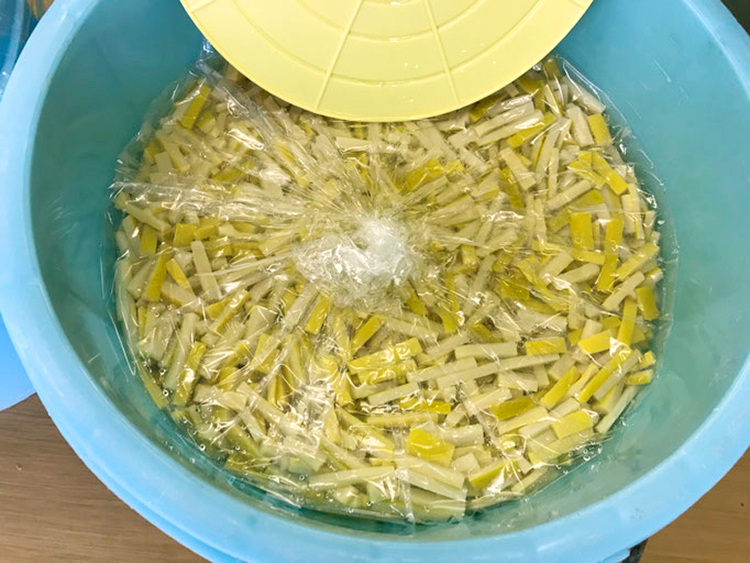
Bamboo contains large amounts of lactic acid bacteria. If lactic acid fermentation proceeds too quickly during storage, the fibers become soft, so the shoots lose their chewiness. Preserving them in a large quantity of salt makes fermentation proceed less quickly, so they store for longer.
Menma was produced on a pilot basis in 2016, and the results were excellent. The following year it was commercialized in partnership with Nittari Yottari, a women’s collective that grows vegetables on abandoned farmland and processes them for consumption. The menma was sold under the brand name Tenryu Inachiku . The idea was to bring in money for the community by having locals produce and sell it, plus generate funds for managing the bamboo forest.
Meanwhile, to ensure the project’s longevity, work began on passing the torch to the next generation. An initiative was launched that got children who were attending the nearby Tatsuoka Elementary School involved in the entire process, from chopping down the bamboo and producing the menma to designing the package and even selling the stuff.
Here the chief role was played by project member Ito Takako, who had previous experience working as a food designer. She educated the children about the aims of commercial design and the tricks of the trade. She also taught them the importance of a selling package design.
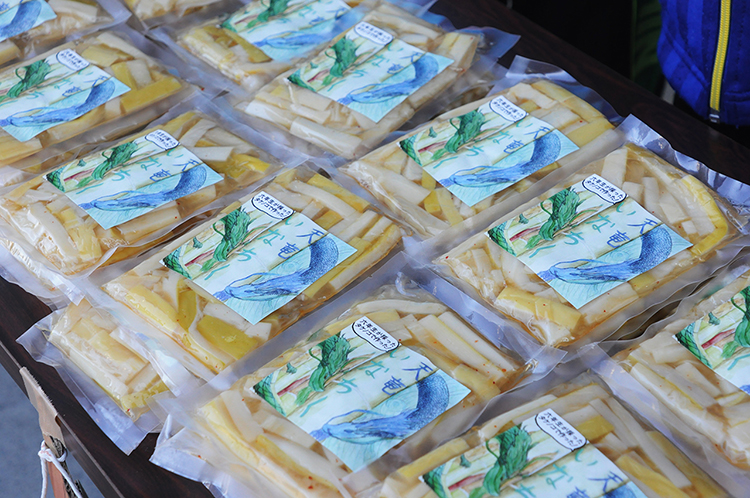
Tenryu Inachiku in a package designed by elementary students.
“It’s a rare experience to be able to turn something grown locally into a commercial product and then sell it,” says Ms. Ito. “The kids looked so proud of their salesmanship. Such a business success story at this point in their lives will undoubtedly serve them well once they enter the workforce. I’m sure it will also spur their interest in the local economy.”
The participants now plan to share their expertise in managing bamboo forests and utilizing bamboo effectively. They intend to expand their activities beyond the narrow confines implied by the name Tenryu River Garyu Gorge Revival Project.
“We want to add more flavors of Tenryu Inachiku and create a greater variety of packaging,” says Ms. Ito. “Our ambition is to develop the Tenryu River Garyu Gorge Revival Project into a broad-based business that gets out the message about our community.”
“Eating menma is a great way to manage a bamboo forest, as we often point out,” notes Mr. Sonehara. “There can be few other foods whose consumption is so directly connected to beautifying the rural landscape. What you eat can change the mountainside and transform the environment. That’s what makes this project so visionary. We hope to pass it on to the next generation in the form of an organization that can keep running on its own steam for years to come.”
